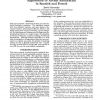Free Online Productivity Tools
i2Speak
i2Symbol
i2OCR
iTex2Img
iWeb2Print
iWeb2Shot
i2Type
iPdf2Split
iPdf2Merge
i2Bopomofo
i2Arabic
i2Style
i2Image
i2PDF
iLatex2Rtf
Sci2ools
ACL
1994
1994
Decision Lists for Lexical Ambiguity Resolution: Application to Accent Restoration in Spanish and French
This paper presents a statistical decision procedure for lexical ambiguity resolution. The algorithm exploits both local syntactic patterns and more distant collocational evidence, generating an efficient, effective, and highly perspicuous recipe for resolving a given ambiguity. By identifying and utilizing only the single best disambiguating evidence in a target context, the algorithm avoids the problematic complex modeling of statistical dependencies. Although directly applicable to a wide class of ambiguities, the algorithm is described and evaluated in a realistic case study, the problem of restoring missing accents in Spanish and French text. Current accuracy exceeds 99% on the full task, and typically is over 90% for even the most difficult ambiguities.
| Added | 02 Nov 2010 |
| Updated | 02 Nov 2010 |
| Type | Conference |
| Year | 1994 |
| Where | ACL |
| Authors | David Yarowsky |
Comments (0)

